I did a study on my children’s head shapes as they went through the milestones. I focused primarily on their head shape at the time of the irritable period of the milestone: before, during, and after. I wanted to just see what I saw. I’ll show my results, for the head shape itself, below.
But what I was really stunned by in doing this study is that, often down to the day, my children had very similar temperaments. Their facial expression, personality, and what they were doing was the same. I’ll show what I mean about this, too. But first head shape and its relationship to behavior:
Brain growth is not unlike physical growth spurts. It is commonly known that when children get taller, they sometimes get “fatter” before they grow. They get a “Buddha belly” then grow sharply, becoming lanky. What I noticed in head shape change during a developmental milestone, a time of brain growth, is similar. It typically followed this order:
- A fairly “normal” head
- A protrusion of the forehead
- An elongation of the forehead
- Growth in the back of the head, bringing the head shape back to “normal”
This is as for three year olds specifically. The protrusion (2) typically preceded irritable behavior, rather, often preceded the very start of the milestone. I’ll show you what I mean:
My third child always showed the most pronounced head shape changes. So, I use him as the example. This shows the first 3 changes in typical head shape change:

This is Three Year Old Milestone 3. It is 3 years, 1 month. There is only one week difference in the photos. In the first photo, his head shape starts off fairly “normal.” This is before the milestone started. There already is some protrusion in his forehead. But not nearly as much as you see in the second photo. It is only 3 days later. And this photo is also before the “milestone” started, meaning just before irritating behavior was noticed. This was very typical. A protrusion in the forehead like this meant irritating behavior was coming soon, perhaps the next day. And in the third photo, there is an elongation of the forehead.
Here is another one with the same 1, 2, 3 progression. In this one, his head had elongated in less than a day, probably after a nap. It is Milestone 7, around 3 years, 4 months.
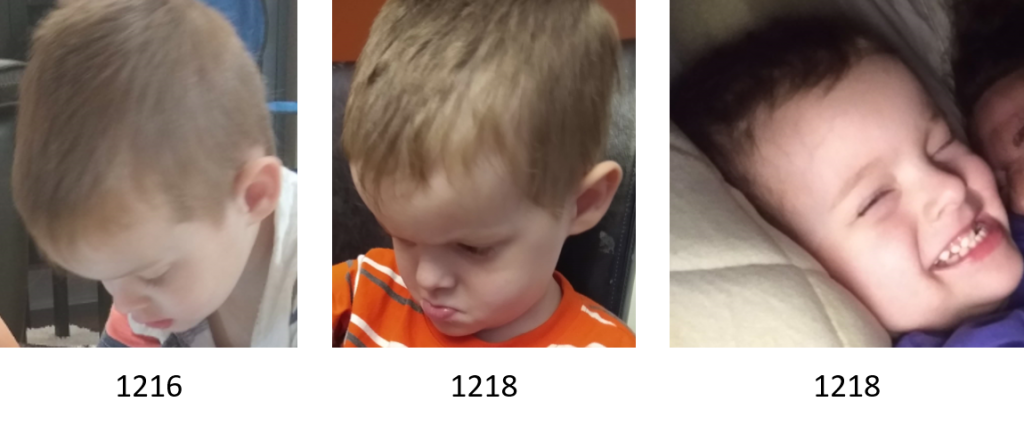
Doesn’t it look like his brain is about to pop in the second photo?
My first didn’t have such a noticeable head shape change. His forehead is naturally more narrow. It got more “scrunched up” during irritable periods, especially towards the top of his head. Here is an example.
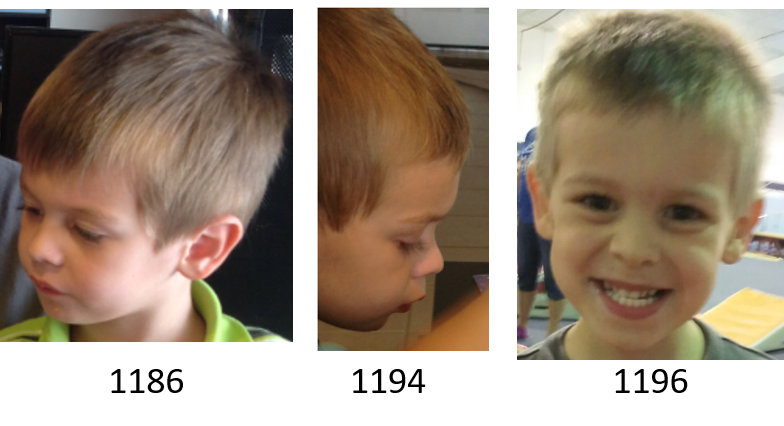
This is his head shape change over the course of Milestone 6A. Can you see how he looks a bit like a “Neanderthal” in the middle photo? That’s about as much of a head shape change as he ever showed. The third photo shows again the elongation of the forehead.
Also, you see a more “egg shaped” head in the first photo and a more “squared” head in the last. I describe their heads as such in some of my descriptions. Egg shaped means the back of the head is more rounded and wider as compared to a smaller face. “Rounded” means the whole head is in balance. And squared off means the sides of the head come up in more of a planar, perpendicular way, as seen in the third photo.
In the following, I attempt to show the last stage of the progression, (4) when the back of the head catches up. I have both my third child and daughter as examples, during the same milestone. It is Milestone 9B, around 3 years, 7 months.
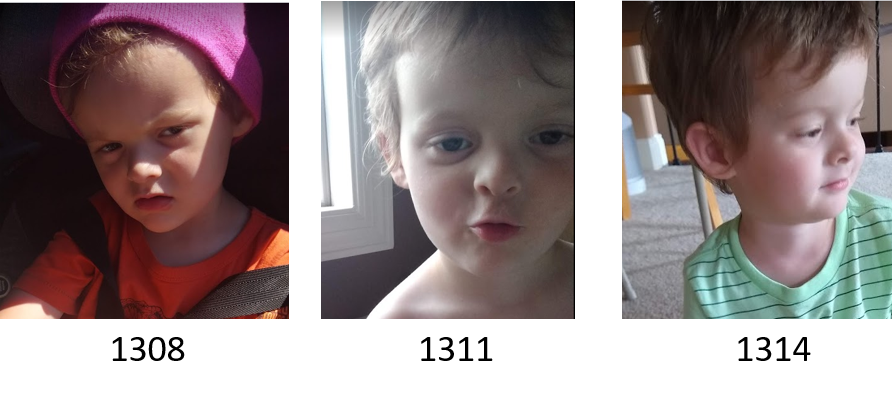
The first photo here of the boy shows first a broad protrusion of the forehead (2), then an elongation (3), then the back of the head gets bigger (4).
My daughter: almost the same, except I don’t have any photo of her to show the first protrusion (2). Here is the same exact milestone but for my daughter:
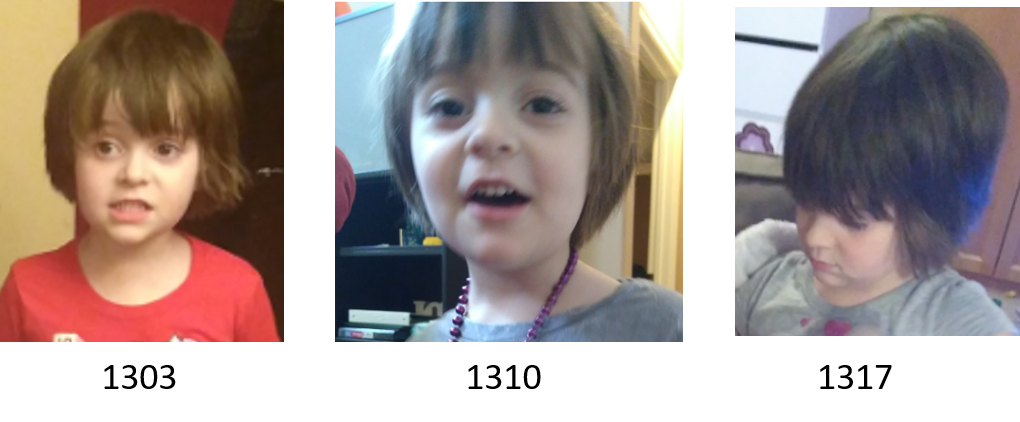
You can somewhat disregard the first photo of the girl in this strip. It’s the best I could find of her for the age range, and it’s too young for to see the forehead protrusion. But you do see the elongation in the second photo. And it’s the last photo I especially want to show. The back of her head clearly gets bigger. It gets bigger identical to the way her brother’s did, in the above strip. It is now more “egg shaped.”
And in the comparison of the two strips above of the boy and the girl, notice how in the third photo the temperament of each is about the same. They are both calm and focused in a cool, contemplative way. These are children who are cool and confident in who they are as people: the essence of the kind of growth across the age of 3. The second photo is similar too: they are both somewhat cheekily playing around with the camera, looking right at it.
It was uncanny to me the number of times I took a photo of my children on the same day of their development, and the picture I took caught them doing about the same thing. Here are more examples:
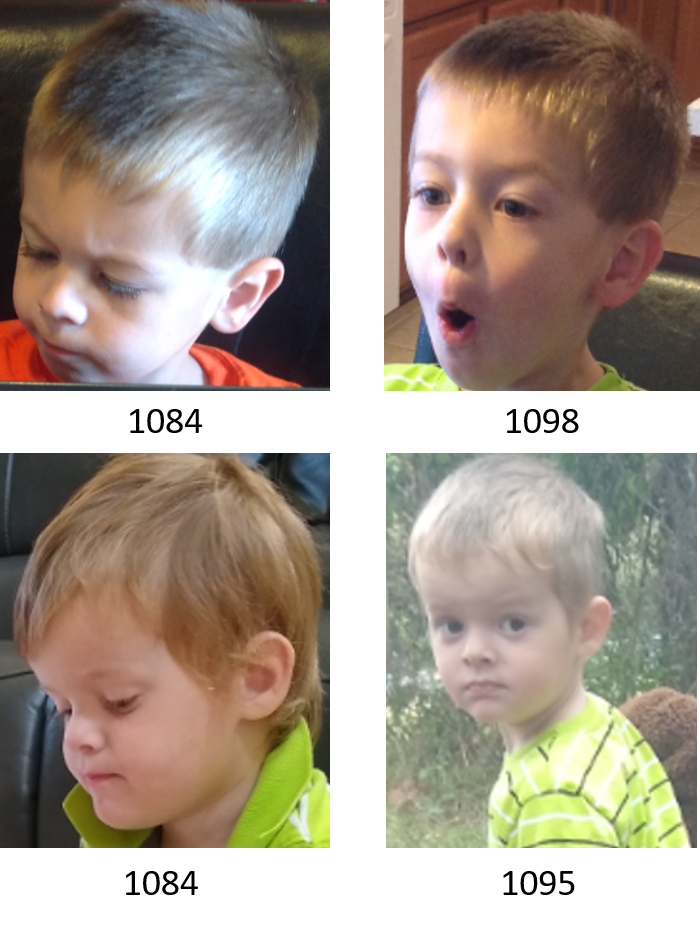
This is Three Year Old Milestone 1. There are two boys, one on the top and one on the bottom. The strip is of each boy before and then after the irritable period.
I was just completely floored when I came across these photos. This was the very first milestone I did. In the first, on day 1084 for both boys, they are both looking down and focused. In the last, they are much more alert, animated, and nonchalant. Think this is all just a coincidence? There’s more.
Here is Milestone 2. I list the days for each: they are nearly identical. These are before and after the irritable portion of Milestone 2:

In the first photos, we see chipper boys with bright eyes. In the last, both are scowling. They are intensely looking at something. I just so happened to get their photos for the second photo for each. I was attempting to catch something entirely different than what are my children’s scowling faces—not something I’d be inclined to photograph. And yet I got it, for both boys, nearly to the same day.
I got used to seeing how common this was, but this one shocked even me. It’s Milestone 10B, before and after. What shocked me is that at on Day 1358/1359, both boys did something nearly identical. They both wanted to play “hero.” The top son wanted to ride his tricycle to the top of a big hill. The bottom son wanted to pretend like he was winning a football game. The enthusiasm and cheerfulness with which both boys did this was identical.
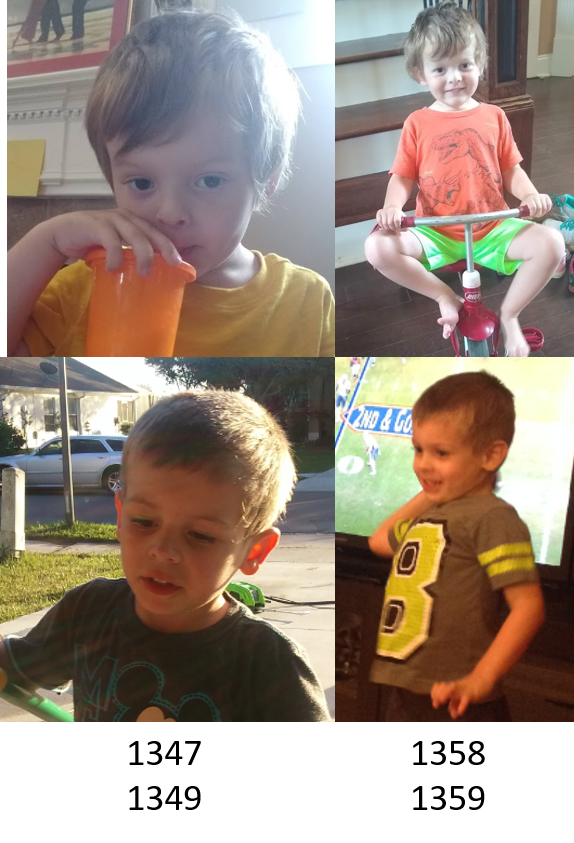
They are similar in the first photos too. The first photo shows what I call a “rounded” head well.
Not to leave my daughter out, here is a comparison between her and her brother (my third) at Milestone 11. My third, the boy, is on the top. My daughter is on the bottom. I’ll let it speak on its own.
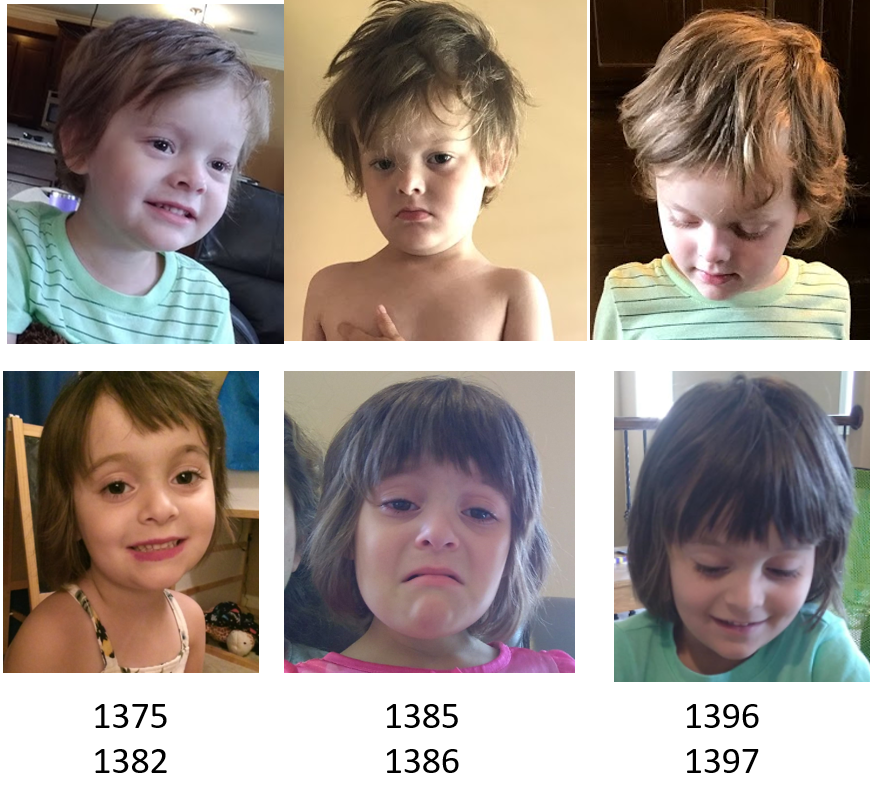
I have quite a few other examples, but I’ll stop here.
I’ve long done work in which I line up children’s behavioral patterns to identify developmental milestones. I’ve been doing this work since 2016, and that’s how I had primarily doing it. I looked at text descriptions of behavior alone. Now, starting with the first edition of this book on three year olds, I also take into consideration their head shape. This brings much more precision and accuracy to the work. Head shape photos can help better align the milestone. For instance, if you were looking at this strip of photos, which only spans 9 days:

And you knew this photo lined up somewhere compared to this developmental stage, which one would you match it to?
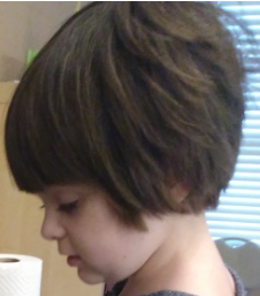
I would line it up with 1218. This photo of the girl is at 1236. The behavior AND head shape were similar such as to make me line up this day in development.
If there is any question on if your child is hitting a milestone at a younger age than most children or if you are hitting the same milestone differently, or whatever the issue, head shape comparisons can help. Ultimately, I think a robust photo inventory of children’s head shapes during brain growth, combined with powerful software analysis, may be the key to pinning down more fully the natural variability in child developmental milestones. Imagine if you could upload a photo of your child and have a computer return to you the likely developmental stage they are in.
It’s true I “just” used photos. Here is one of my arguments about that, though: what truly amazed me in looking through their photos was not just what the shape of their head was, with all of its dimensions, but what their personality was on any given day as well. Truly, we can’t just study the head shape and measurements of children. We need to see live children, in a free environment, to truly study child development. That spark, that vibe, is what this work captures, and what candid photographs capture.
I can agree though that more thorough analytical measures can bring yet more insight. To do this work fully, we would need the following: a calculus expert, a statistician, a psychologist, and the most difficult expert to find: someone so good with children as to document the child’s head shape daily. This would mean 1) taking meticulous head measurements daily, 2) drawing a sketch of their head daily, or 3) getting a child to sit for the ideal photo daily. Right.
Anyway, the calculus expert can size up the shape of the child’s head: calculus is the study of the calculating the area under an object (including unusually shaped objects). The statistician can help figure out the variability of the milestones. The psychologist can verify behaviorally the child is in X milestone. What you need most however is the person good with children. This is no small thing—and tampering with a child too much would compromise child development results, i.e. they become irritable. I think it’s somewhat safe to say you can glean a lot from mere photos, all things considered.
I don’t show all results of my head shape study in this book. If I lined up head shapes of each child at each milestone, at some point it just starts to look like class pictures of students lined up in a high school yearbook. Instead, just know that I did do this to bring better precision to the work. I otherwise only grab relevant photos for things I find important at any given milestone. In doing so, I hope to illuminate what your child is going through better.
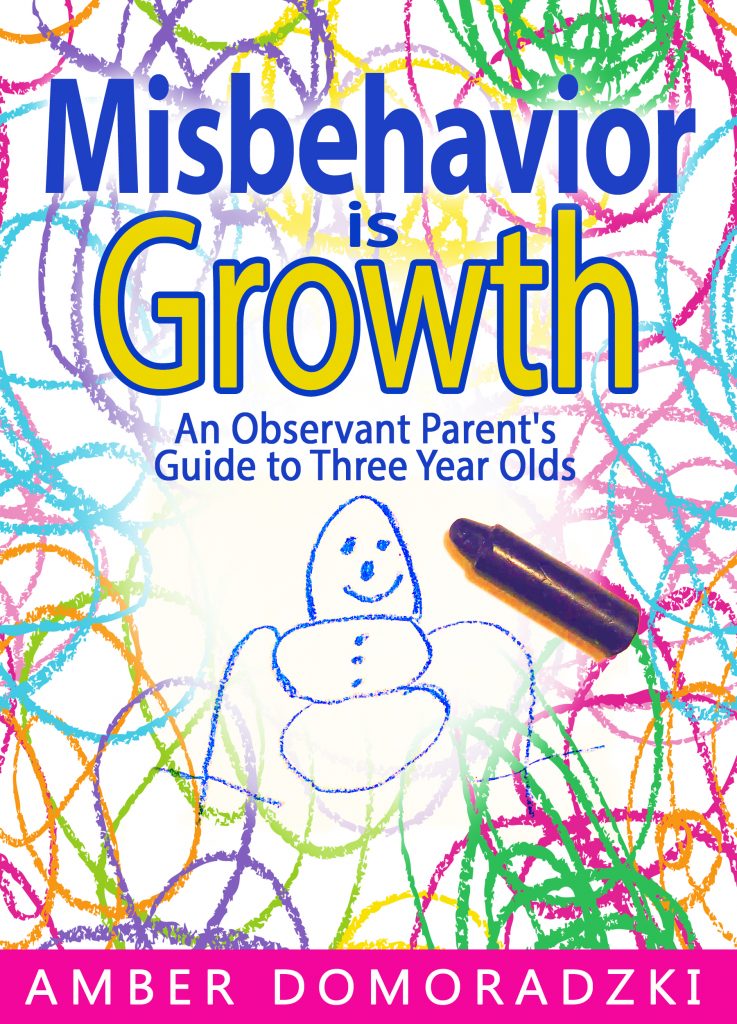
Come check me out on Facebook as “The Observant Mom” or on Instagram as @theobservantmom. Please share this with a friend–or researcher–who may be interested

I’m Amber, aka “The Observant Mom.” See my child development work, documenting the age-related stages children go through at www.theobservantmom.com. Tell a friend!
One thought on “Head Shape Comparisons During Children’s Brain Growth”